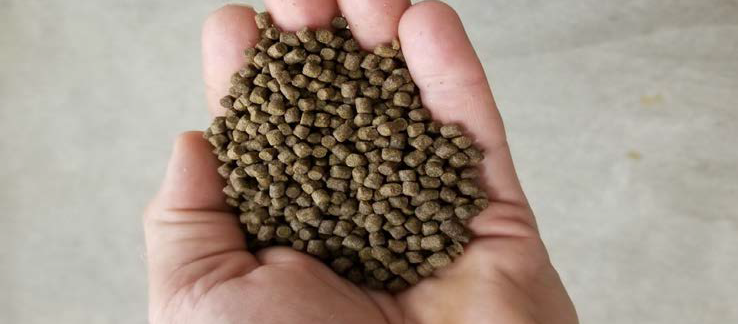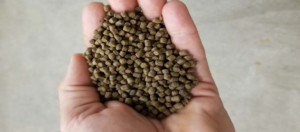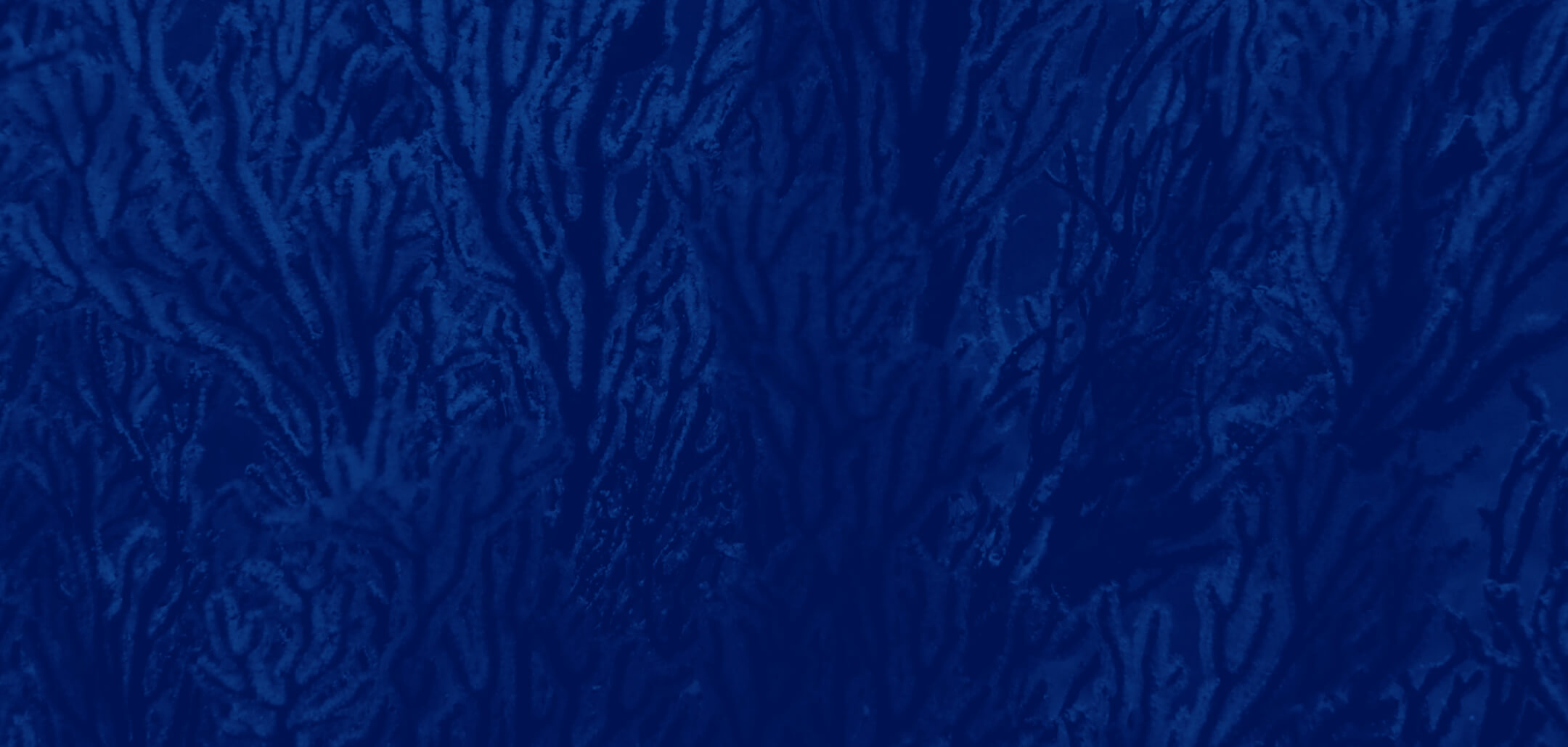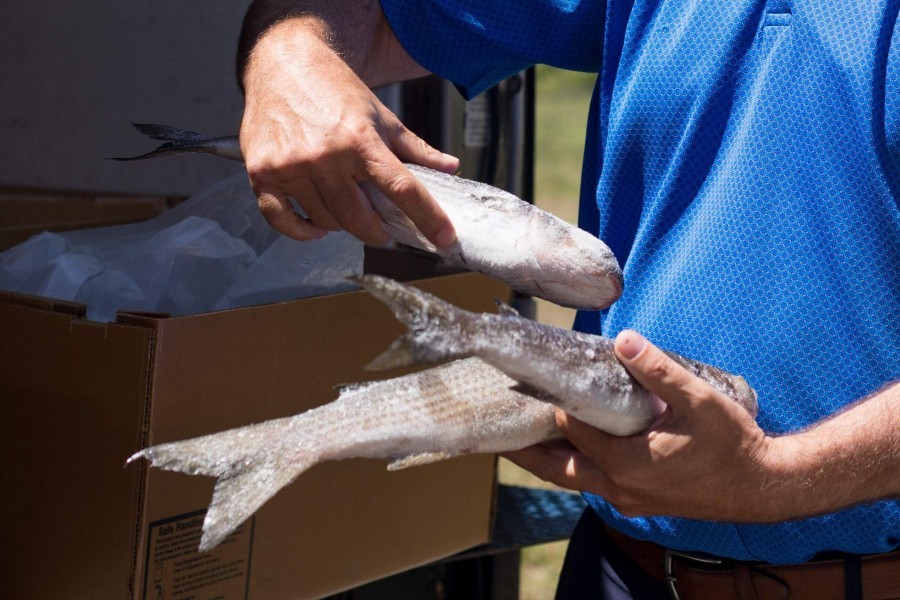Seafood farmers can raise fish successfully on a diet made with leftover, wild-caught mullet—a discovery that can improve sustainable seafood farming and add value to a major Florida fishery—reports a Mote Marine Laboratory study supported by Gulf Coast Community Foundation.
Study partners fed farmed fish a newly developed diet made with whole, striped mullet (Mugil cephalus)—a species fished to produce valuable bottarga (cured roe), leaving behind meat and oil that are underutilized. In the study, the mullet-based diet supported excellent growth, health and survival in farmed fishes—nourishing a freshwater fish species as effectively as a commercial diet, and nourishing a saltwater species more effectively than a commercial diet.


Photo: One of the diets used to feed aquaculture-raised fish in the new study. Credit: Mote Marine Laboratory
Farming animals and plants in water, known as aquaculture, supplies more than half the planet’s seafood and must continue growing because most wild fish stocks are overfished. To help aquaculture feed more people with less environmental impact, Mote scientists have developed recirculating marine aquaculture systems that recycle 100% of their water at Mote Aquaculture Research Park (MAP) in eastern Sarasota County, Florida.
One big challenge is how best to feed aquacultured fishes—many of which eat other fishes in the wild. Commercial aquaculture diets usually contain some wild-caught fish meal from species including menhaden, anchovies, sardines and herring, but these fisheries are limited and they play important roles in ocean ecosystems. As fish farming continues to expand around the world, the importance of identifying alternative protein sources is increasing.
In 2016, Mote launched an effort to do just that, after competing successfully for funding from Gulf Coast Community Foundation in the 2015 Gulf Coast Innovation Challenge to grow Florida’s ocean-driven, “blue economy.”
“We saw a unique opportunity to transform a locally available by-product—excess mullet from the fishery in Cortez, Florida—into a valuable fish meal product that could be used in commercial aquaculture feeds. Using excess mullet in aquaculture diets helps both fishers and farmers realize economic and environmental benefits for their industries, their consumers and the oceans,” said Dr. Kevan Main, Manager of the Marine & Freshwater Aquaculture Program at Mote.
“At Mote, we have long recognized that sustainable aquaculture must grow at an accelerating pace to help feed the world, and projects like Dr. Main’s aquafeed study are vital for meeting that need,” said Dr. Michael P. Crosby, President & CEO of Mote. “Mote’s scientific staff—particularly the outstanding innovators at our Mote Aquaculture Research Park—are deeply grateful to Gulf Coast Community Foundation for supporting our advancement of the science needed to expand our blue economy.”
“Our Innovation Challenge was all about inspiring and seeding new ideas that could produce an economic impact for our region with environmental benefits,” said Mark S. Pritchett, President/CEO of Gulf Coast Community Foundation. “It was a long play, but Mote followed through on this project and has clearly realized that potential.”
Mullet represented the largest commercial fishery by weight in Florida as of 2014. Mullet bottarga is one of southwest Florida’s largest exports, but mullet flesh is in lower demand and is often discarded once a female’s eggs are removed, and for males in general.
Recognizing an untapped resource, Mote scientists and the Chiles Restaurant Group worked with southwest Florida fishermen to obtain excess, whole mullet, and Mote worked with a commercial feed company, Zeigler Brothers, Inc., to formulate and manufacture a mullet-based diet for aquacultured fish. The Mote study compared three diets: the new mullet-based diet; a menhaden-based diet; and a standard commercial diet. They tested each diet with two farmed fishes: freshwater Siberian sturgeon and saltwater red drum (redfish).
- Siberian sturgeon:
Mote scientists placed 350 juvenile, freshwater, Siberian sturgeon into each of nine large tanks in 2016 at MAP. Three tanks were fed the mullet diet, three the menhaden diet, and three a commercial diet appropriate for the species. Throughout the 77-day research trial, Mote scientists observed excellent growth, feed conversion rates (how efficiently animals convert food to weight gain), health condition and survival across all three diets, and statistical analyses revealed no significant differences among their performance. The juvenile sturgeon approximately quadrupled in weight after 11 weeks. Sturgeon fed the mullet diet contained higher abundances of beneficial bacteria associated with production of antioxidants, vitamin B12 and antimicrobial effects. - Red drum (redfish):
In 2018, Mote scientists stocked each of 12 tanks with 175 juvenile, saltwater red drum and fed four tanks the mullet diet, four the menhaden diet, and four a commercial diet appropriate for the species. Over this 96-day study, the researchers observed excellent growth, survival and feed conversion rates again for all diets once again. Juvenile redfish tripled or quadrupled in weight, and this time, the mullet diet clearly performed the best. Mullet-fed red drum weighed more than those fed the other diets—a statistically significant difference. Also, mullet-fed red drum grew significantly faster (as measured by specific growth rates and thermal growth coefficients) and converted their food to weight gain more efficiently than fish fed the other diets. Mullet-fed red drum harbored different bacteria, including types that aid digestion and may increase nutrient availability.
“This study demonstrates the potential to use the mullet-based fishmeal as an alternative fishmeal resource,” Main said. “The success of the feed trials is not measured by simply the best growth and performance; the real success is that the mullet-based diets performed as well as, or better than, the standard commercial and menhaden-based diets.”
This success, Main and partners note, offers an opportunity to add value and expand jobs for the Cortez area mullet fishery, one of the oldest existing fisheries in the country.
Main said: “Hopefully, this will motivate other seafood communities and aquaculture producers to identify potential sources of valuable fishmeal and alternative protein sources.”
With the successful completion of this project, Mote scientists, in collaboration with scientists at the National Center for Mariculture in Israel, are undertaking new studies to expand knowledge of alternative aquafeeds—including various algae and bacteria known as “periphyton.” Mote scientists are also working to apply aquafeed data from their own studies and others around the world to develop the new Mote Aquafeed Decision Tool (MAQFEED): An artificial intelligence software tool to help fish farmers and aquafeed makers choose sustainable, productive and affordable fish diets.


